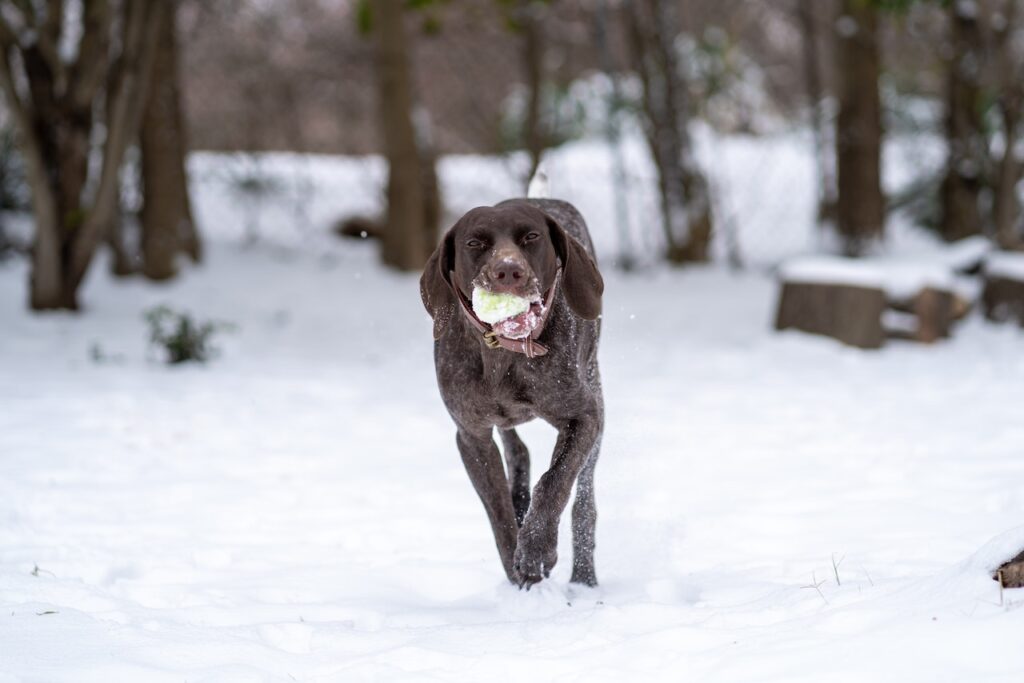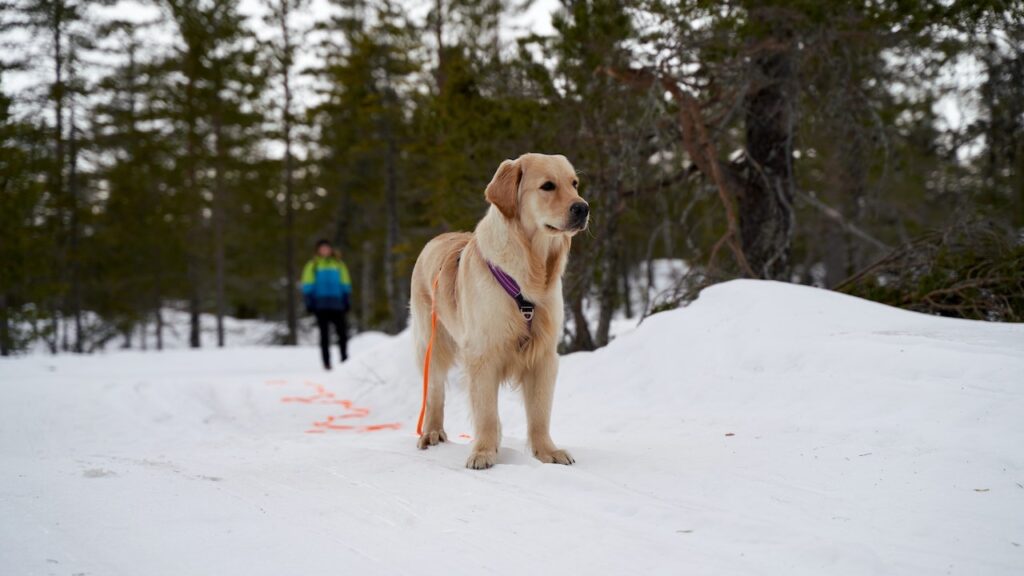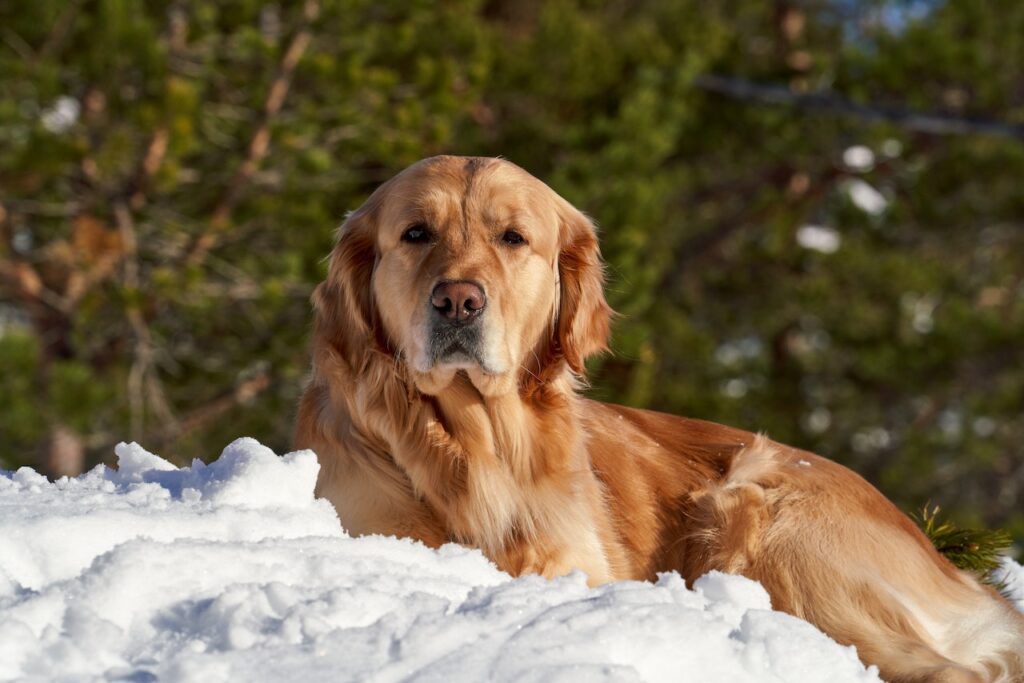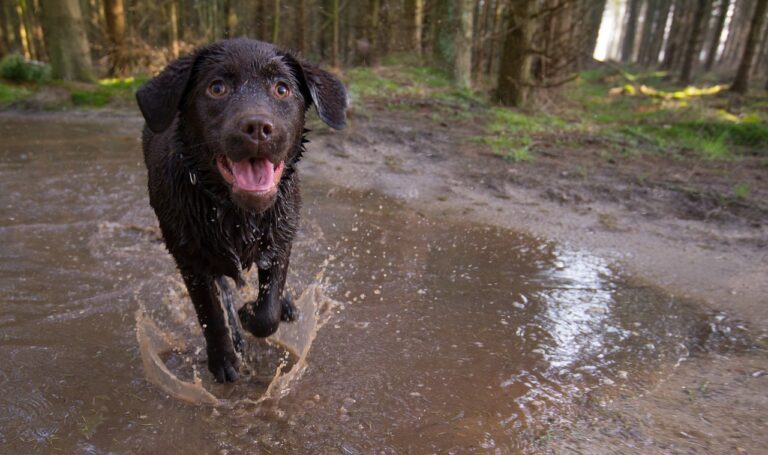Can Labrador Retrievers Handle Cold Weather?
Do you want to know how Labrador retrievers can handle cold weather? One of the most popular dog breeds in the world is the Labrador Retriever due to its friendly temperament and loveable disposition. They were originally developed as working dogs in Newfoundland, Canada, and have a variety of characteristics that make them adaptable to many circumstances. Many Labrador owners may be concerned about their beloved pals’ ability to withstand the cold weather.
The traits and adaptations that Labrador Retrievers have that make them successful in colder areas will be discussed in this article. A remarkable capacity to resist and even enjoy lower conditions is shown by Labrador Retrievers, who have a thick double coat, a strong physical structure, and an active lifestyle. Come along as we explore the intriguing world of Labrador Retrievers and their love of the cold.
History of Labrador Retrievers
The capacity of Labrador Retrievers to flourish in cold weather conditions has a long history. The Labrador Retriever breed first appeared in Canada’s Newfoundland and Labrador on the coast. They were first developed as working dogs by local fishermen and hunters in the 19th century.
A robust, water-resistant double coat with a short, thick topcoat and a soft, insulating undercoat is what Labrador Retrievers have. They benefit from this coat’s protection from the cold and chilly waves. Additionally, it allows them to swiftly dry off after swimming or coming into contact with moisture, which was crucial for their original function of recovering wildlife from the water.
Fishermen utilized Labrador Retrievers largely to help them recover lost fishing gear, including nets, ropes, and fish. They were well equipped for this work, especially in the chilly and choppy North Atlantic seas, with their water-resistant coat and great swimming ability. Due to their remarkable retrieving abilities and terrain adaptation, Labrador Retrievers were accepted as hunting partners. They were exceptional in tracking wildlife on land and retrieving ducks in frigid and snowy circumstances.
The Labrador Retriever’s sturdy physiology evolved to tolerate the cold over many generations. Their coat serves as insulation, shielding them from chilly conditions. Additionally, they have webbed feet, which let them swim and walk on frozen surfaces. They also have robust physiques and powerful muscles that enable them to traverse rocky terrain and withstand inclement weather.
Early in the 20th century, Labrador Retrievers became well-known, and finally, they were recognized by kennel clubs and breed associations all over the globe. Their appeal as working dogs, family pets, and service animals in both cold & warm locations was largely due to their adaptation to different conditions, amiable temperaments, and flexibility.
The Coldest Weather Labradors Can Handle
Although most temperature-related health issues in dogs are due to hearing, keeping your Labrador outside in the cold for an extended period may also have negative effects. Most Labradors can withstand temperatures as low as 20 F before approaching a dangerous area. However, other elements may worsen exposure to cold weather and endanger your Labrador at temps over 20 F.
🐕Snow and Water
The danger of hypothermia significantly rises when there is snow or water present. If your Labrador’s coat becomes wet or they must stand in the snow for a long time, their body is more likely to freeze & shut down swiftly.
Do all you can to keep them indoors if it’s pouring or snowing outdoors. If you must let them out, do it quickly, and keep an eye on them the whole time they are outdoors.
🐕Wind Chill
The wind chill is another meteorological occurrence that may intensify the impacts of cold weather. Given the current temperature, you should also consider the wind chill levels while determining if it is safe for your Dog to go outdoors. Keep your Dog indoors if the temperature falls below 20°F (32°F for elderly, young, or ill Labs).
🐕Size and Age
Your Labrador’s age and size majorly affect how much cold it can tolerate. Full-size Labradors in good health ought to be OK at temps as low as 20 F. Any temperature below 32 F puts Labrador pups, senior Labradors, & sick Labradors in danger.
Additionally, just because your Labrador is theoretically unharmed at 20°F or 32°F does not imply they will like the cold. At temperatures about high as 45, many dogs begin to experience discomfort from the cold.
Generally, keep your Dog indoors when the weather is very chilly. It would help if you didn’t expose them to chilly temperatures unless they have to go outside to the restroom since they don’t enjoy the cold and prefer to be inside, where it’s cozy and warm.
🐕Hypothermia
Hypothermia is the greatest danger for dogs that are exposed to extreme cold. When your Dog is exposed to chilly temperatures, you must exercise extra caution since this condition may be lethal, similar to heatstroke. Here is a list of typical Labrador hypothermia symptoms to wrap up this post and help you protect your Dog over the winter:
◽️Irrational Shivering
◽️Howling or Wailing
◽️Overall Deficiency
◽️Desire for Warmth
◽️Mental Drudgery
◽️Consciousness Loss
Dog Cold Temperature Guidelines
Most dogs shouldn’t typically have a problem with cold temperatures until they drop below 45° F when certain cold-sensitive canines could feel uneasy. Owners of small-breed dogs, dogs with thinner coats, and dogs who are extremely young, elderly, or ill should pay particular attention to their pets’ health when the temperature drops below 32° F.
All dog owners should know that their canines may become susceptible to cold-related health issues, including hypothermia and frostbite, if temperatures fall below 20° F. The easiest way to watch dogs in the cold is to observe their behavior closely. It’s time to go inside if you see your Dog shaking, acting agitated, whimpering, slowing down, looking for a warm place to be, or holding up one or more paws.
Reasons Why Labradors Enjoy the Cold Weather
You want to ensure their safety and health, as with any other dog. You may be concerned about your Dog’s safety, whether very hot outside or extremely cold indoors. If you own a Labrador, you may have observed that they want to be outdoors even in freezing weather. Why is your Dog acting this way? Is it secure? Do you need to worry? The answers to all of these queries are provided here, and they should ease your worries as a pet owner.
👉Labradors are Made to Survive the Cold
It’s important to understand the Labrador Retriever’s history before anything else. If you weren’t aware, labs were developed with thick coats to enable them to endure the cold without discomfort. In the summer, Newfoundland, where Labs are bred, seldom reaches temperatures above 60 degrees. The daily average temperature is 32 degrees throughout the winter. Their thick, water-repellent coats were beneficial to fishermen when they were hunting dogs in this Canadian province.
They tugged ropes between ships and drew nets out of the ocean. And these Labs would routinely chase birds on land. These fishermen required canine friends that could resist the cold and aid them since the weather was so extreme and low. To achieve just that, the Labrador Retriever was specifically developed.
👉They Have Double Coat
As was already said, Labs worked in chilly environments close to a lot of water, which is where their distinctive coat goes into play. Due to their thick, short, & water-repellent double coat, Labradors could formerly endure the subzero temperatures and chilly water they often worked in.
If you own a Lab, you have undoubtedly observed it sheds at different periods of the year. Labs thrive in the cold, even though this may be annoying and need a lot of cleanup. Their undercoat and topcoat, made of fur, provide insulation for their body heat.
It’s almost as if your Dog is covering their naturally hairy body with a stylish fur coat. Therefore, it’s possible that your Lab likes the cold because it makes them feel more at ease than they adore it.
👉Some Cold-Weather Safety
Again, even if your Labrador was developed to withstand the cold, it may still be vulnerable to dangerous weather conditions. Shivering is a clear sign that your Dog is ready to enter the house. Look closely for any indications of frostbite on their ears, paws, and tail. Fido may have frostbite if you see any swelling, blistering, discoloration, or signs of evident discomfort.
Inspect and clean your Dog’s paws as they enter the house. Rock salt and hazardous deicers might aggravate your Lab’s paws. Before letting your Dog outside, consider applying foot balm or placing it on dog boots.
Just because your Labrador can endure subfreezing conditions does not imply they should be kept there for extended periods. Contact your veterinarian immediately if you have any reason to believe your Dog may be ill after exposure to the cold. This will enable you to determine if there is no reason for concern or whether a major issue warrants their attention. When it comes to your canine friend, always err on caution.
👉There Can Be Too Much Cold
Undoubtedly, there may be too much cold. Your Labrador has a chilly tolerance limit; they are not impervious to the elements. Your Labrador can often withstand temperatures as low as 20 degrees, but not all dogs can.
The common cold could aggravate any existing issues in your Dog if they haven’t recently had a clean bill of health from the vet and haven’t been examined lately. If your Dog is healthy, make sure they have enough food and water in the winter, maybe even a little more. These additional calories will be turned into heat-producing energy to help your Lab remain warm.
Another wise maxim to remember is that if it’s too cold for you, it’s also too cold for Dog Warm. Keep a watch on them while they are outdoors if you are unsure so you don’t forget they are there.
How Different Ages of Labradors React to Cold Weather
The most vulnerable to the cold are puppies and elderly Labradors. Puppy health and energy aside, they are still weak, making them significantly more susceptible to illnesses.
Older dogs often have lower energy levels and weaker immune systems, making them more susceptible to illness. Always take safety measures to prevent your Dog from getting hypothermia or frostbite.
Due to their weakened immune systems, sick Labradors should get extra care since they are more vulnerable to infection. Always keep sick and elderly pets safe and warm, particularly in the winter. Dogs’ capacity to control body temperature declines with age. Senior labradors are hence more vulnerable to the impacts of cold weather. They could need more attention and care, such as warm beds and suitable outdoor clothing.
Labrador Retriever Temperature Tolerance
The first Labrador Retrievers were bred in a coastal Canadian village. They assisted the fishermen with hauling in nets to catch fish that managed to escape the fishermen’s hooks. These experimental Labrador Retrievers spend plenty of time in the water helping people get their job done by locating items submerged in the sea, like fishermen’s nets.
The average summer temperature in Newfoundland is 61°F (16°C), but the average winter temperature is a chilly 32°F (0°C). At first, this may seem like an unrelated anecdote unrelated to Labrador’s tolerance for temperature variations. The highest recorded temperature is 77°F (25°C).
Labradors swam in the Arctic Atlantic Ocean and worked under these freezing circumstances. Because of their decreased body surfaces, like smaller ears & shorter tails, Labradors are more tolerant to cold environments than hot ones.
Can Labradors Sleep Outside in the Cold?
Labradors are not suited to spend prolonged time sleeping outdoors in cold weather. Compared to breeds developed expressly for cold areas, labradors have a short, thick double coat that offers some insulation but are generally more sensitive to the cold. While Labradors may be able to endure moderate cold weather for brief durations, sleeping outdoors in subfreezing temperatures or difficult winter circumstances is not desirable or advised.
Risks associated with the cold include frostbite, hypothermia, and respiratory problems in Labradors. Cold weather exposure for an extended period may cause pain, sickness, and even significant health issues. During the winter months, providing your Labrador with the proper shelter, warmth, and protection is crucial.
Ensure your Labrador has access to a dry, insulated doghouse and shelter with appropriate bedding, such as blankets or straw, to offer warmth if it must spend time outside in cold weather. To keep your Dog warm while engaging in outside activities, consider using dog-specific winter apparel, such as jackets or sweaters. However, in really cold weather, putting their safety and well-being first by taking them inside is preferable.
How to Care for Your Labrador Retrievers During Winter
The following are some suggestions for winter pet care for labrador owners:
☑️Utilize Insulated Kennel
Keep your Dog in an insulated kennel to avoid getting a cold or becoming unwell due to the weather. To ensure your Labrador is warm & cozy, you may purchase a sturdy, insulated kennel.
An excellent kennel keeps your Labrador cool in the summer and cozy in the winter. It should be warm enough for your Labrador to sleep in and insulated to prevent heat loss to the environment. It should also be roomy to prevent your Dog from feeling crowded or confined.
☑️Limit the Amount of Time Your Lab is Outside.
Whether or whether your Labrador spends a lot of time outdoors, you should still set limits. Spending a lot of time outdoors might increase your Dog’s risk of contracting illnesses and cause problems like hypothermia & frostbite.
☑️Consider a Winter Checkup for Your Dog
Before winter sets in, you must take your Labrador for a checkup. You may use this to determine its precise state of well-being and how it feels physically. Additionally, it will highlight any medical issues your Dog has, allowing you to plan your winter preparations.
☑️Give Your Dog a Balanced Diet and Plenty of Water.
More calories are burned when you shiver than when you remain stationary. During the winter, you should give your Dog additional food and water to boost immunity and compensate for the extra calories it burns.
Dogs are more susceptible to dehydration in the winter, so make sure they always have access to clean drinking water. Aim to keep the water from being too cold to avoid causing problems for your Dog’s body and the environment.
☑️Put on Winter Protective Gear for Them.
To keep your Dog warm, you may outfit it in protective clothing. The most delicate portions of your Dog’s body are his chest and feet, so make sure they are protected.
☑️Watch Cautious for Frostbite.
When the body’s extremities freeze due to low temperatures and a lack of heat, it results in frostbite. Even though your Labrador has a double coat, it might still get frostbite.
It would help if you didn’t leave your Dog outdoors unprotected for extended periods to prevent frostbite. Make sure your Dog is warm and well-protected before letting it outside. Dogs with diabetes, heart conditions, or other chronic ailments are more prone to frostbite.
Environment-Related Elements That Affect Temperature Tolerance
The breed’s ability to tolerate different temperatures is influenced by various circumstances, making it difficult to provide a clear-cut response. Humidity & wind chill (ex., inside ventilation and outside wind) are the two environmental conditions that affect a Labrador’s tolerance to temperature the most often.
High air humidity levels diminish the efficiency of the Labradors’ panting. Condensation, rather than evaporation, occurs when the air is at or almost saturation. For Labradors, 86°F (30°C) with 70% saturation is normally the highest critical temperature. The Labrador’s thermoregulatory systems become less efficient if humidity levels rise beyond 70%, and the animal will start to overheat at 86°F.
Convection works best when the wind moves quickly over the Labrador’s body. On windy days, the heat loss by wind convection will grow, and the Labrador will be less resistant to low temperatures. The opposite is also accurate. The Labrador can tolerate temperatures of 3 to 5 degrees over the neutral zone on hot, windy days.
The Influence of Health Status on Temperature Tolerance
A Labrador’s ability to tolerate heat will also fluctuate if their health is damaged. For instance, hypothyroidism, which results in a lower metabolic rate, affects the ability of Labradors to produce heat. As a result, hypothyroid Labradors will be less tolerant of the cold than normal Labradors.
A Labrador through an infection-induced fever is another situation that will lead them to have abnormal thermoregulatory processes. The brain of the Labrador retriever sends messages to the body, telling it to warm up because it is chilly.
The Labrador then starts to shiver and exhibit behavioral indicators that they are attempting to stay warm. The Labrador’s core body temperature rises due to greater heat output and conservation; Labradors often die at temperatures over 106°F (41.1°C).
Hottest Temperatures Labrador Retriever Can Handle
In general, adult Labradors can withstand temperatures of approximately 90 F. However, you shouldn’t simply judge whether it’s safe for your Dog to spend a lot of time outside based on the temperature on a hot summer day. The following factors must also be considered.
Your Dog must have access to a lot of water when the temperatures are particularly high. Water is always essential for your dog, but hot summer days are when it’s most crucial. It’s so important because panting is how dogs cool themselves. All the heat that leaves their body must exit via their lips since they lack the multitude of sweat glands that humans have to cope with excess body heat.
Water must be refilled often to keep your Labrador Retriever comfortable and avoid heatstroke since panting consumes a lot of water. Therefore, even if the temperature is slightly lower than 90 °F, but your Dog cannot access any water, it is still far too hot for these pets to be outside.
Frequently Asked Questions
Does my Labrador Retriever get cold at night?
Even when kept inside, dogs are still susceptible to nighttime cold. Consider giving your Dog a warm blanket to cuddle up in bed if you suspect he is becoming cold at night. Most dogs won’t feel cold at night, or if they do, they’ll look for a warmer location, according to Satchu.
When ought your Labrador Retriever to be brought inside?
When your Labrador is out in the cold, it’s crucial to keep an eye on them. Watch for warning signs like shivering, decreased lethargy, and the Dog feeling excessively cool that it’s time to bring them inside. Senior and obese Labradors should be closely watched during the colder months as they may have trouble controlling their body temperature.
What degree of heat is safe for a Labrador to walk in?
Although it is generally safe up to 19°C (68°F), exercise caution when the temperature exceeds this. Dogs are susceptible to heat stroke even in low temperatures of 20°C (70°F). In essence, dogs who experience heat stroke have a high body temperature unrelated to a fever.
Are winter coats required for Labrador retrievers?
Putting a coat or jumper on double-coated dog breeds like Labradors is not advised since they are already well-suited to withstand the winter weather’s components.
Does a Labrador have a cold fear?
Your Labrador can often withstand temperatures as low as 20 degrees, but not all dogs can. The common cold could aggravate any existing issues in your Dog if they haven’t recently had a clean bill of health from the vet and haven’t been examined lately.
Final Words
Labrador Retrievers are perfect for handling cold temperatures. Although Labradors are naturally tolerant of cold temperatures, it’s important to remember that they can still become ill in extremely cold temperatures. Because Labrador Retrievers are born able to thrive in colder climates, responsible pet ownership involves keeping an eye on them, giving them the care they need, and making decisions that will keep them safe and comfortable no matter the weather.











